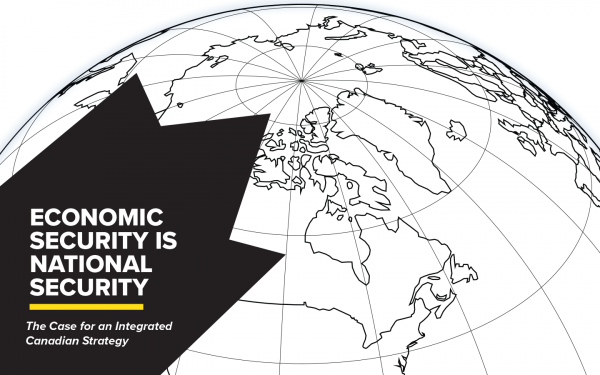Canada-China relations: keeping up the momentum
Summary
Introduction
China will be crucial to Canada’s economic future over the next 50 years. China is, and will remain, Canada’s 2nd largest national two-way trade partner after the United States. In every sector, from government to business to the daily lives of Canadians, China will affect our economic opportunities and increasingly shape global politics. The question facing Canada now is how do we wish to engage with China going forward? And how can we take a more proactive role in shaping the relationship?
In this report, which was requested by the Canadian Council of Chief Executives (CCCE) as part of its continuing series of papers on Canada in the Pacific Century, McKinsey explores the answers to these questions.
Our first objective is to present a business case for broader cooperation with China. We focus only on the business opportunities rather than broader sociopolitical issues, which are well covered elsewhere. Every day, Canadian firms—a number of which are members of the CCCE—are engaging in new commercial opportunities with Chinese partners across sectors. These ventures, which are profiled in this report, are a positive step. However, structural government-to-government relationships could be improved to more proactively seize opportunities. We highlight six sectors that are of particular mutual interest and also align with the goals outlined in China’s 12th Five-Year Plan and the 18th Third Plenum: clean technology, natural resources, agriculture, transportation, infrastructure, and aerospace, as well as services that include education and finance. In addition to providing a rationale for prioritizing these sectors, we aim to dispel the myths that can make businesses cautious in pursuing opportunities and offer best practice tips for success.
Our second objective is to present the business viewpoint on what stronger engagement with China might look like. We hope this report will serve as a starting point for other parts of Canadian society to articulate their views on how Canada can step up to the challenge.
Our first step in evaluating sectors of mutual benefit was to review the 2012 Joint Canada-China Economic Complementarities Study released by the two governments. Given the social, economic, and environmental impact China will have on Canada and the world, we believe Canada must have a plan for
strengthening its ties and advancing Canada’s and China’s mutual interests. Capturing the opportunities presented in China will necessitate a significant strategic effort by both the business community and the Canadian government— requiring businesses to highlight the jobs and opportunities that can flow from a more structured relationship and governments to invest more proactively while engaging in more frequent discussions between the most senior Canadian officials and Chinese leadership.

Part I: China’s Next Chapter
Macro trends
Canadian business leaders seeking to capture the massive economic opportunity in China need to be aware of three macro trends. Unlike variable trends in preferences and political inclinations, these macro trends will determine the nature of Chinese economic, political, and social life over the coming decades.
First, China—like much of the world—is witnessing a historic wave of urbanization and industrialization. Each year, approximately 15 million to 20 million people move to cities in China. By 2030, China’s total urban population is expected to be almost a billion. This dramatic internal migration has significant consequences for consumption, production, infrastructure needs, political power, and institutional development. It also has consequences for China’s global economic role. By 2025, 100 of the 136 cities joining the list of the world’s 600 most economically powerful cities will be from China, and so will 7 of the 13 new megacities. The future of urban development, infrastructure, transportation, consumption, and production will be largely written in China.
Second, the migration of citizens to cities in China is closely linked to another macro trend—the rise of the Chinese consumer. In the past decade, urban Chinese consumers’ disposable incomes have risen by over 245 percent. As urban incomes and consumer spending continue to rise between 10 and 15 percent per year, half of the 2.2 billion new middle-class consumers created by 2030 will be in China, presenting one of history’s largest consumer market opportunities.
Designing consumer goods that match the tastes, lifestyles, and needs of the Chinese consumer is an imperative for Canadian exporters.
Third, these 1.1 billion new consumers will drive increasing demand for energy, materials, agricultural products, and other resources. China’s market for meat, already the world’s largest, is expected to grow by over 60 percent. China will also account for over 40 percent of the global growth in energy demand by 2030. These material demands will put further strain on the quality of China’s air, water, and soil, and the regulations to protect them. China is already the world’s largest carbon emitter—and its domestic air pollution is of increasing concern to its citizens and policymakers. Canada has a unique opportunity to combine its extensive resource advantages with its capabilities in environmental protection to take the lead in helping China meet its growing resource needs.
Government priorities
Given these profound shifts, the Chinese government has expanded its view on the kind of development required. Although the government continues to emphasize GDP growth, with plans targeting an annual increase of approximately 7 percent, about half of the provinces’ leaders will no longer be assessed solely on GDP growth metrics. In its Five-Year Plan, China has committed to transforming its development model, emphasizing four priorities:
- Expanding domestic consumption
Long considered an export, infrastructure, and heavy-industry economy, China is now seeking to improve its domestic consumption environment, increase its middle classes’ income, and enhance its public services. - Transforming industries
Chinese authorities and business leaders are aggressively pursuing highervalue-added industries, actively encouraging domestic innovation, moving to a more services-oriented economy, and improving manufacturing. - Sustaining development
Given its increasingly severe environmental problems, China has begun to implement green regulations, create ambitious targets for renewable energy generation, reform factor pricing structures, and develop a “circular economy” to redirect material flows away from waste. - Promoting social harmony
China has re-emphasized its long-stated priority of ensuring social harmony by spreading the benefits of prosperity more evenly, increasing employment, and closing income gaps. It has also placed an emphasis on improving public services and stabilizing housing, especially for new urban residents.
In addition, the Third Plenum held in November 2013 built on the priorities set out in the Five-Year Plan and expanded them. While sustainable development and social harmony continue to be important themes, the government has now emphasized the need for efficient market mechanisms and the necessity to streamline the relationship between governments and market. The focus on market mechanisms would likely lead to a more level playing field for all enterprises—whether MNCs or local companies.
After the Third Plenum, the government also announced the “Decisions on Major Issues Concerning Comprehensively Deepening Reform” to start laying out the specifics. For instance:
- Expanding domestic consumption
- Increasing household income
- Financial sector: deregulate deposit rates and encourage product innovation and investment opportunities for households
- Land: enhance the circulation of rural land rights, unleashing greater wealth and opportunity in rural communities
- Reduce contingency savings
- Hukou: relax Hukou criteria, reducing the uncertainty and contingency savings for urban residents without Hukou
- Social safety: enhance wage protection and pension/healthcare protection
- Increasing household income
- Transforming industries
- Market liberalization
- Open up the service sector, thus creating service jobs
- Introduce private players and deregulate price, letting competition force companies to increase their capabilities/productivity
- SOE: enhance the governance and management, partly through private capital injection and the use of employee stock ownership plans; raise the contribution to the social safety net to 30 percent of profit by 2020
- Financial
- Develop the capital market
- Accelerate interest rate liberalization
- Accelerate capital account liberalization
- Market liberalization
- Sustaining development
- Energy: deregulate the energy price; apply a resource tax
- Family planning: allow a couple to have a second child if at least one member of the couple was a single child
- Local government finance: enhance transparency and control of local governments’ debt, and allow the issuing of construction bonds
- Promoting social harmony
- Hukou: accelerate Hukou reform, which will allow the migrants to stay at their jobs longer and have better opportunities to receive appropriate training
- Social safety: enhance wage protection and pension/healthcare protection.
Different layers of government are already working on the implementation details for some of these initiatives—e.g., the single child policy.
Each of these priorities presents unique opportunities and challenges to Canadian businesses. Instead of continuing to view China as a low-cost producer, consumer goods firms will need to shift their focus to the vast numbers of Chinese consumers and ensure their new products and services are designed accordingly. Furthermore, energy and resource firms can no longer expect that the Chinese market will continue to increase consumption without introducing more regulations.

Part II: Canada’s Opportunity for Trade and Investment
Canada-China trade
Canada and China have a history of mutually beneficial trade and investment relationships, with growing collaboration within the natural resources, renewable energy, and manufacturing sectors. Today, China is Canada’s 2nd largest national trading partner, while Canada is China’s 13th largest trading partner. Canada primarily imports consumer goods, including electronics, communications equipment, and machinery, whereas China tends to import resource-related goods such as metal ores and paper products, as illustrated in the following chart. Despite the historically resource-intensive trade between Canada and China, trade in services between both countries is trending upward, increasing more than 50 percent from 2007 to 2012. There is also a shift toward trade in value-added goods like manufacturing exports.
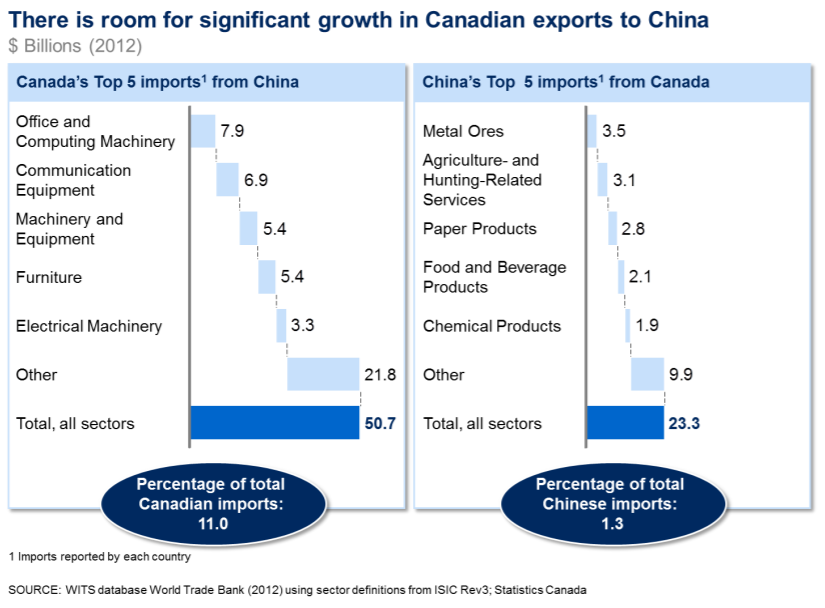
Nevertheless, Canada remains a much smaller partner to China than other countries with similar complementary sectors. For example, Chinese imports from Canada only represent 1.3 percent of total imports, which is low when compared with those from Switzerland or Germany (where imports are 1.5 percent, and 5.1 percent, respectively).
Moreover, there is high supply in Canada and high demand from China in a number of industries, yet China has stronger trade relationships with other countries. Canada only provides 0.2 percent of China’s total petroleum and gas compared with Saudi Arabia, which provides 19 percent, Angola, which provides 14 percent, and Russia, which provides 9 percent. Similarly, China has high supply in industries such as machinery and equipment manufacturing and electrical machinery but only supplies 10 percent and 16 percent of imports to Canada compared with the United States, which provides 56 percent and 46 percent respectively. As such, opportunities exist to expand trade in key industries where both Canada and China have ample supply.
In terms of the investment relationship between Canada and China, foreign direct investment (FDI) has been growing across a range of sectors. In 2012, cumulative Canadian FDI in China was estimated at US $9.7 billion and cumulative Chinese FDI in Canada reached US $20.0 billion, making China Canada’s 2nd largest foreign direct investor in the world. According to China’s State-Owned Enterprises and Canada’s FDI Policy, 1 if the current proportion of Chinese FDI stock in Canada remained constant, China could—based on the projected scale of China’s FDI by 2020—provide 40 percent of the estimated funding required to optimally develop the oil sands. There is huge opportunity for partnership, but Chinese capital will move elsewhere if Canadian markets prove hostile. Further improvements could also be made to improve the transparency of financial information from Chinese companies, which is vital to encourage further market-based transitions and growth in two-way investment.
An opportunity exists for Canada to capture a greater share of trade and investment from China when compared with other global trade partners that have similar capabilities to meet the growing demand.
China’s requirements
China has identified seven new strategic industries—environmental conservation, renewable energy, renewable energy vehicles, IT industries, biologics, high-end manufacturing, and new materials—as part of its action plan. The Chinese government has set ambitious targets to support this plan and drive growth. Chief among these is to increase the share of GDP contributed by these industries from 1 percent today to 8 percent by 2015 and 15 percent by 2020. In an effort to move away from manufacturing toward a more consumption-based economy, the government also aims to increase the service industry’s share of GDP from 43 percent to 47 percent by encouraging new market entry and service areas. As a number of selected industries—including financial services, education, and healthcare – become increasingly deregulated, additional opportunities will open up for foreign companies with proven reputations and capabilities.
Canada’s capabilities and assets
China’s strategic industries align with a number of key sectors where Canada has a competitive advantage. Its capabilities in clean technology to support environmental conservation, its vast supply of natural resources, its best-in-class agriculture, transportation, infrastructure, and aerospace sectors, and its capacity within a number of service industries (including education) enable Canada to meet China’s interests and requirements while supporting essential value-adding industries within the Canadian economy.
- Clean technology. Canadian clean tech companies are innovative and hold proprietary technologies that can support China’s goals to improve environmental conservation. China has 16 of the world’s 20 most polluted cities. Under growing global pressure to improve, China has set ambitious targets: 100 clean energy cities, 200 clean energy counties, 1,000 clean energy demonstration zones, and 10,000 solar energy demonstration towns. Canada and China have also begun to increase their level of collaboration in this sector. China’s import of clean tech goods from Canada has grown from US $19.9 million in 2001 to US $63.1 million in 2011, primarily for wind generators and smart grids. The Ontario-China Clean Air Technology Workshop has been established and includes an international team that brainstorms ways for local green tech companies to leverage Canada’s research and development expertise. Moreover, under the Canada-China Framework Agreement for Cooperation on Science, Technology and Innovation, seven projects valued at over $10 million have been approved, ranging from new solar cells for energy panels to wind-energy and sea-water desalination systems.
- Natural resources. Canada is China’s 16th largest supplier of natural resources, providing only 2 percent of China’s total sector imports. Yet Canada—as one of the world’s leading exporters of energy, mining, and forestry products—is well-positioned to play a much greater role in supplying China’s rapidly increasing demand for natural resources. For example, in 2011, over 80 percent of China’s energy was produced by nonrenewable coal, whereas over 60 percent of Canada’s electricity generation came from renewable sources. As part of its Five-Year Plan, the Chinese government aims to decrease its dependency on coal and reduce its energy intensity (measured by coal equivalent use per unit of GDP) by 16 percent. To reach this target, China will need access to Canada’s uranium and has already begun to increase its imports. In October 2013, the Canadian uranium company Cameco made its first shipment to China as part of two long-term uranium supply deals—one with China Nuclear Energy Industry Corporation for 23 million pounds of uranium concentrate through 2020 and the other with China Guangdong Nuclear Power Holding Co., Ltd. for 20 million pounds through 2025.
- Agriculture. Canada ranks as the 8 th largest exporter of fish, seafood, and agricultural commodities and products worldwide, with total exports valued at US $45.7 billion in 2011. In terms of products, Canada is one of the world’s top five exporters of wheat and canola and a large exporter of beef and pork. China has become the 3rd largest destination for agricultural products worldwide and is expected to become the world’s largest agricultural importer by 2020. Demand is growing within China for many of Canada’s agricultural products, with food exports valued at $5 billion in 2012. Canola products—seeds, oil, and meal—are worth about $3 billion annually, and exports by volume are up about 15 times early 2000 volumes. Moreover, as Chinese consumers grow more affluent and develop western tastes, demand for meat and seafood has increased; pork exports nearly quintupled between 2008 and 2012. Demand for premium products such as lobster and ice wine is also growing rapidly.
China is striving to build its domestic agriculture sector by building capabilities and adopting new technologies and innovation. China’s demand for human capital and expertise in this sector is growing. Canada’s considerable expertise in innovative approaches to breeding and its supply of potash fertilizer products have been of particular interest to China.
For example, Hypor, a pig genetics company in Canada, has been cooperating with New Hope Group, one of the largest feed and pig breeding companies in China, to build two pig genetics farms in China’s Shandong and Sichuan provinces. Canada, the world’s 2nd largest canola producer, is also exporting genetically modified canola seed (or rapeseed) to China.
China is the world’s largest consumer of potash and Canada plays a large role as a primary global source. Yet China recently acquired a 12.5 percent stake in the Russian potash producer Uralkali that competes directly with Canada’s potash industry. Canada should proactively strengthen Chinese relationships and deepen its understanding of the microeconomic decisions of Chinese farmers, the policies governing profit pools, and the supply chains in China. This would better position the Canadian potash industry to grow in this market.
- Transportation, infrastructure, and aerospace. Canada is the world’s 5th largest exporter in aerospace and is recognized globally for its competitive expertise in high-level project management, its specialized technical skills, and its proprietary transportation, infrastructure, and aerospace technologies. As a result of its massive urbanization, China will need to spend over $16 trillion between now and 2030 (6.4 percent of its GDP) to maintain its infrastructure stock and support growth. In the next 10 years alone, China will build 97 new airports (Canada has 26 commercial airports), 35,000 kilometres of new expressways (Canada has 38,000 kilometres), and 30,000 kilometres of new rail tracks (Canada has over 46,000 kilometres). China has already begun investing in building a series of regional airports that will require smaller, lower-cost planes that the Canadian aerospace sector is wellsuited to supply. Leading Canadian aerospace companies like Bombardier are known for specialized regional jets such as the Q400. Bombardier is also developing the CSeries commercial jetliner, which is particularly targeted at markets like China. The Chinese air services industry is already the world’s 2nd largest market, and China will account for over 12 percent of the world’s total aircraft sales in the next 20 years. Canada has the opportunity and expertise to play a big role in this growing sector.
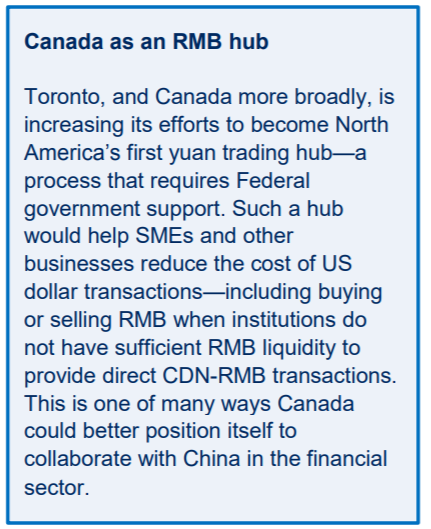
- Services. This is an important and growing sector for the Canadian economy, increasing from 65 percent of Canada’s GDP in 2000 to over 70 percent in 2012. It is also a major driver of employment and economic wealth, employing approximately three-quarters of all Canadians. The share of service exports to China is increasing and China has further committed to opening up over 60 percent of its domestic services sector, which will include various levels of deregulation in finance, health, and education.
Canada’s finance sector is well-regarded globally for creating a regulatory environment that ensures high-quality customer service and a less volatile banking sector that hedges against risk. Canada’s public pension funds are particularly known for exemplifying best practices and for the extent of their investment abroad.
Four of the world’s 40 largest pension funds are Canadian, and they manage about $640 billion in assets. The majority of this capital is invested outside Canada; for instance, the Canada Pension Plan Investment Board invests nearly two-thirds of its $193 billion in assets internationally. The Economist recently praised the performance of these “maple revolutionaries,” noting that they are well-governed by well-compensated investment experts.
This makes Canada a natural place for China to explore as it continues to upgrade its regulatory and governance practices in its finance sector. Compared with China, and most other places in the world, Canada has taken a more balanced approach to finance—leadership of the triple bottom line (economic, social, and environmental impact) and the importance of a longterm investment mindset. Two prominent Canadians, Mark Wiseman (CEO of the Canada Pension Plan Investment Board) and Dominic Barton (the head of McKinsey & Company globally) recently published an article in Harvard Business Review observing that the vast majority of Board members and C-suite executives think that a longer time horizon would positively affect corporate performance, including better financial returns and greater innovation
The education sector is also a major opportunity for Canada. It is already Canada’s 11th largest export, bringing in more revenue than coal or softwood lumber. China has over 400 million school-aged youth to educate each year and a projected shortage of 23 million skilled workers by 2020.
Within China, there is a plethora of opportunities for Canadian educational institutions. Families dissatisfied with the quality of instruction offered in state-run schools, or simply looking to give their child every possible advantage, are often willing to invest a substantial amount of their income in education. Furthermore, although estimates of the number of English language learners in China vary considerably, a 2010 report in the official China Daily suggested 400 million Chinese are now learning or using English; other estimates indicate that 40 percent of them learn in professional English language agencies. These numbers indicate a significant opportunity for Canada that is largely untapped. Globally, Canadian provinces have 84 offshore and international schools, three-quarters of which are in Asia. Institutions like the Schulich School of Business in Toronto operate satellite centres in Beijing and Shanghai. These programs meet only a tiny fraction of Chinese demand for English skills and western cultural knowledge.
Within Canada, educational institutions are being far more aggressive about recruiting Chinese students. Over the past decade, Canadian schools have increased foreign admissions by 75 percent, enrolling 265,000 full-time students, making the country the 6th largest player in global education. Recently, the Federal government’s new international education strategy targeted increasing this number to 450,000 foreign students studying in Canada by 2022. Moreover, Chinese students represent just under a quarter of all international tertiary students in Canada. The government has also taken positive steps to develop and implement an international education strategy by allocating $10 million of the Federal budget to the sector over 2 years. Ensuring education remains a priority sector will be an important part of capturing this opportunity
Canada’s capabilities, geographic proximity, and strong ties to China resulting from our large Chinese immigrant population all suggest that both countries would benefit from a deeper relationship across mutually advantageous strategic sectors. Canada’s relationship with China is currently limited to the WTO, yet China has the most to gain from the potential elimination of tariffs through economic partnership. A study on the impact of Canada implementing unilateral free trade revealed that the largest market share gain, an estimated $7 billion in additional imports, would go to China, whereas the share of imports from the United States would decrease as a result of rebalancing distortions created by uneven tariffs and negotiated preferences. Therefore, Canada should engage China strategically to negotiate a mutually beneficial partnership and reciprocity in a trade relationship. Understanding the size of potential benefits to China will put Canada in a stronger negotiating position.
Risks and considerations
Although these opportunities have great potential, they also pose certain risks, including restricted capital inflows and outflows and markets dominated by under-performing SOEs. China’s recent reform policies are a first step toward reducing some of these risks.
State-owned banks dominate China’s banking sector, accounting for more than half of China’s bank deposits and savings and about 20 percent of domestic loans exposed to local government financing. Moreover, repatriating income from China and foreign exchange can be difficult as capital flows into and out of China are strictly controlled and regulated. China’s reform initiatives include some deregulation of the financial sector, including the introduction of private banks that will increase competition for cash deposits and loans. China is already piloting a free trade zone in Shanghai, which will serve as a testing ground for China’s economic reforms. Experiments with reforms to deregulate service industries, financial reforms to promote private banking, and the new free trade zone pilot where FDI will flow more easily signal a change in SOE dominance.
Other signals include the recent China 2030 report developed by the World Bank, Development Research Centre (DRC), and senior officials from the Ministry of Finance that supports scaling back the state’s role in economic activity, reforms to improve corporate governance, and an expanded role for the private sector. The report targets a reduction in the SOEs’ contribution to industrial output from 27 percent today to 10 percent by 2030. The SOEs’ share of employment, output, and industrial assets is already starting to decline—they provide only 20 percent of jobs and approximately a quarter of total output versus private companies that provide 75 percent of jobs. Overall, these signals indicate a movement away from SOEs and toward greater market access and competition.

Part III: Dispelling Common Myths About Doing Business in China
A number of myths have been obscuring the opportunities and limiting Canadian business leaders’ commitment to the Chinese market. Debunking these myths will be important if Canada is to capture the Chinese market’s full potential.
Myth 1 – Wage inflation in China is eroding the cost advantage, resulting in manufacturing moving back to Europe and North America
Although the cost advantages of producing in China may decrease, other strategic advantages will remain. As Chinese demand rises, manufacturers have new incentives other than cost for locating in China. It is true that some manufacturing has returned to North America. Higher wage costs and a decreasing working population resulting from decades of the one-child policy are the primary drivers of this shift. However, China is still an increasingly attractive manufacturing location due to its proximity to demand and local content rules that act as a prerequisite to market access.
Proximity to demand can also improve supply chain efficiency and ensure product innovation is more relevant to local markets. More than two-thirds of global manufacturing activity takes place in industries that tend to locate close to demand. China is one of the most attractive and fastest growing markets for many consumer products. In addition, it is stimulating R&D in the strategic industries in its Five-Year Plan, providing an even greater incentive for Canadian companies to increase their presence there.
Local content regulations—especially in strategic industries like aerospace—also create an incentive to produce in-market using local manufacturing. Over 50 percent of joint ventures in China are entered into for strategic reasons, primarily for building local capabilities and strong government relationships within China. Furthermore, productivity is quickly increasing in China, offsetting wage inflation.
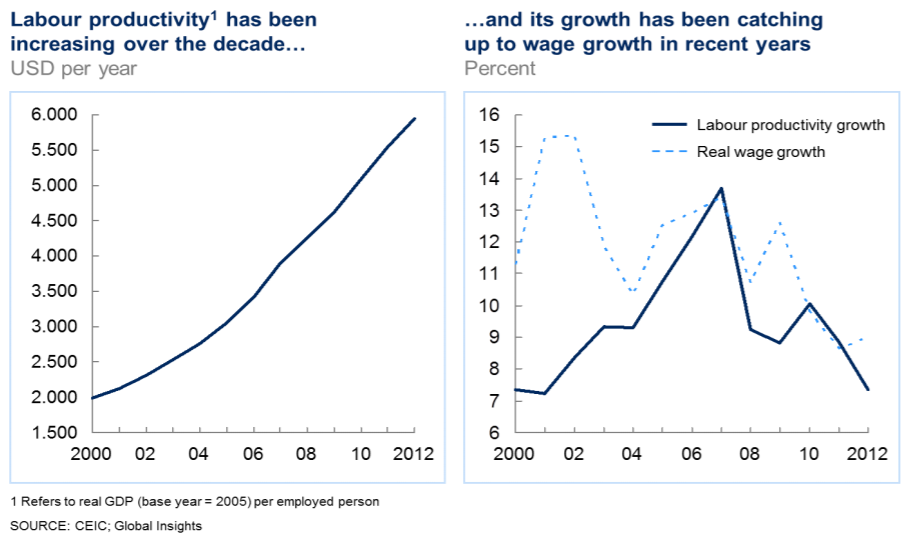
Myth 2—Innovating in China is too risky because of poor intellectual property (IP) standards
As China’s domestic innovation expands, its incentive to protect intellectual property will also increase. Even though its IP standards still lag those of North America and Europe, they are improving. The government ministry charged with prosecuting IP violations recently announced that it handled 2,347 cases in 2012, which is up almost 40 percent from 2011. Many companies that were hesitant to invest in China because of their IP concerns are now carefully proceeding, following varying strategies to protect their intellectual property. Some companies like Shell have successfully avoided IP issues by using public bidding or co-development. For example, Shell-CNOOC purchased and licensed 13 protected technologies through an international public bidding process that created reputational risk and real economic costs to its local partner should adverse IP outcomes result. Other practices include compartmentalizing knowledge so that only a few individuals have a complete understanding of complex core systems. Although IP issues remain a concern, an increasing number of companies believe they can be paid fairly and protect their technology. It is also important to note that partnership agreements are often principle-based and will evolve based on the relationship.
Myth 3—China is a manufacturing hub rather than an innovation or productivity hub
Traditionally, the Made in China label has been associated with low-cost production. Yet, more and more, China is positioning itself as an increasingly competitive and innovative player in the global market. China’s R&D expenditure as a portion of GDP increased 220 percent between 1996 and 2011, and China will have the world’s largest R&D workforce by 2015. Cost pressures such as wages, material prices, and currency appreciation are also driving the demand for better productivity. These increases in innovation and productivity, as well as institutional reforms, have helped move China from 46th place in the World Economic Forum’s Global Competitiveness Index in 2005 to 29th in 2013.
The Chinese company Midea recently surprised the consumer electronics and appliance industry by announcing a highly efficient, 1-hertz, variable-speed air-conditioning compressor before its foreign competitors. Entry and growth of more innovative companies such as Huawei (telecommunications), Haier (consumer electronics and appliances), Baidu (web search), and Tencent (entertainment and media) show a move away from manufacturing to more valueadded businesses. For example, Huawei has developed innovative new smartphone platforms built on chips and software designed in-house.

Part IV: Next Steps for Canadian Governments and Businesses
Business leaders in both Canada and China have identified additional actions that Canada’s governments and business leaders could consider taking to capture the opportunities in China.
This section outlines ideas for ensuring Canada is in the flow of discussions with the right players, prioritizing efforts and investment, and making our country an even more hospitable place for investment. It also provides ideas for helping ensure private sector success when investing or operating in China.
Six ideas for Canadian governments to capture the China opportunity \
- Increase investment in diplomatic relations between the highest-ranking officials from both countries
The time nations and their diplomatic missions invest in China has varied widely. Germany and the United Kingdom, for example, have often sent their heads of state (Prime Minister or equivalent) on diplomatic trade missions to support the development of deeper trade relationships and to create trust and signal the importance of credibility in the negotiations. Such meetings have been linked to trade deals between countries and landmark deals for businesses of visiting countries. For example, a $4.4 billion deal with Airbus was signed during a German diplomatic mission to China, led by Chancellor Angela Merkel. Canada, however, has lagged its G20 peers in the number of diplomatic meetings with top officials. In Asia, and China specifically, leader-to-leader relationships are the foundation for the future of the relationship.
- Make strategic bets on key sectors where Canada wants to grow and China has high demand
In negotiations with countries like China that have a growing interest in investing and acquiring natural-resource-based companies, the Canadian government has an opportunity to promote other priority sectors where Canada has a competitive advantage but lower demand. For example, as China expands its aerospace infrastructure, it will need an increasing number of small-sized regional jets and Bombardier is well-equipped to meet this demand. Other examples of Canadian players in industries that align with China’s seven strategic industries include Westport Innovations in clean technology and PotashCorp in natural resources.
Promoting these industries alongside resource-intensive capital investment deals would help ensure that they would also benefit from access to Chinese markets. Moreover, government leadership in supporting groups of Canadian companies in sectors linked with strategic emerging industries can help boost these sectors in a market where government support is often inextricably linked to private sector success. Government regulators and agencies could seek feedback and learn from successful Canadian businesses operating in China and from the China-based Trade Commissioner Service.
- Clarify Canada’s foreign ownership rules and investment policies to promote transparency and ease of investment
For years, Canada has welcomed foreign capital to invest in R&D, develop its resources, build infrastructure, and maintain its high living standards. The question now is whether FDI from new sources, new countries, and new investment partners—and at higher levels than in the past—is welcome.
China has a long history of investing in Canada. In the past few years, however, China has signalled its desire to move from holding minority stakes to seeking controlling interests in certain cases—and it is making big bets in Asia and Latin America based on their proximity and potential. Since Canada and North America overall are competing for a small share of China’s FDI, Canada will need to become more attractive to Chinese investors. Taking the time to help Chinese firms understand how to operate as successful Canadian businesses will be necessary to gain a larger share and improve investment performance.
The changes to the Investment Canada Act (ICA) placed significant limitations on acquisitions of control by SOEs in the oil sands, which has had a severe effect on investment in the sector. M&A activity in the Canadian energy sector was down more than 80 percent in 2013 from 2012, and overall transaction activity in the oil sands was the lowest in a decade. In a recent example, the China Investment Corporation (with US $580 billion in assets under management) debated moving its North American base from Toronto to New York given its growing interest in the recovering US economy and its concerns about poor investment performance in the Canadian energy and resource sectors.
To address these issues, the Federal government and the provincial governments of Alberta and British Columbia have prioritized efforts to persuade Asian SOEs and other foreign investors that their investment in the oil and gas sector is welcome. Alberta has signed a framework agreement with China’s National Energy Administration to give the province access to Chinese decision-makers. The BC Minister of Natural Gas also received a positive response during a trade mission in Asia to further LNG prospects. Nevertheless, the Federal government will need to make a greater effort to explicitly encourage SOE participation and reverse the negative impacts experienced to date.
It is vital to note that Canadian law applies to the operation of all of these investments. China’s capital, combined with Canada’s knowhow and governance, should be welcomed. Opportunities for Canadian investments in China are also a priority of the relationship.
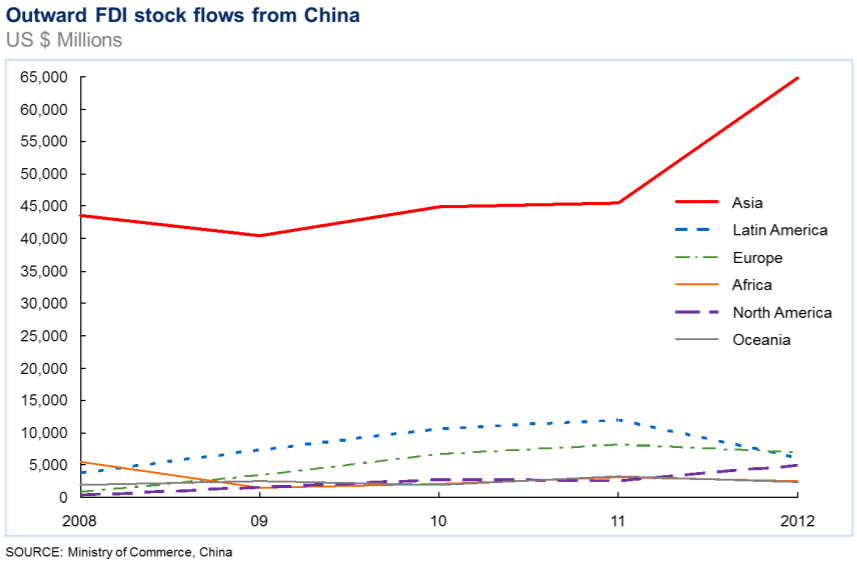
- Prioritize diplomatic staff allocation and investment in top Chinese megacities rather than fragmenting resources
Canada lacks a substantial diplomatic presence in China’s megacities. These megacities represent the top cities by projected contribution to global GDP growth from 2007 to 2025 and should be a major priority for governments and businesses. The top 600 cities will be home to over 2 billion people or 25 percent of the global population, which is equivalent to 735 million households, and they will account for $64 trillion or 60 percent of global GDP in 2025. Yet Canada’s investment in these future megacities is inadequate—it does not have a consulate in two (Shenzhen, Tianjin) of the six current Chinese megacities. It does, however, have an embassy or consulate in all non-Chinese megacities. In fact, Canada has more than three times as many diplomats per capita in the megacities outside of China as it does in Chinese megacities.
To begin to address this issue, the Canadian government created the 2012 Global Market Action Plan to concentrate its efforts on markets that hold the greatest promise for Canadian businesses. The plan was developed in consultation with more than 400 Canadian businesses and industry stakeholders to identify new markets, strengths, and opportunities. The recent announcement of four new trade offices opening in China in fall 2014, boosting the number of trade commissioners to 100, is encouraging.
Succeeding in the top growth markets of the future will require continued prioritized investment and review of market entry implementation plans.
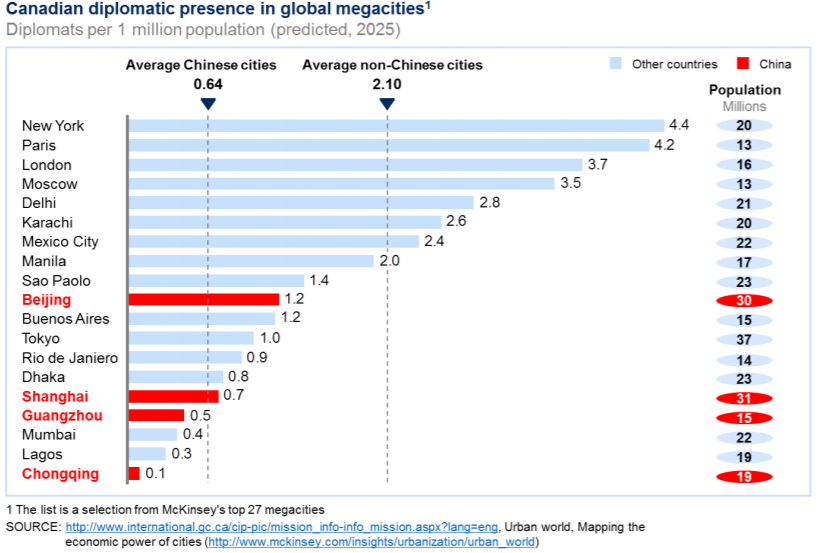
- Promote deeper educational and cultural ties by providing enhanced education for Chinese students in Canada through employment and alumni networks
Canadian companies need workers with knowledge of and experience in Asia to compete in those growing markets. Last year, the poll by Asia Pacific Foundation of Canada (APFC) found that 6 in 10 companies struggle to find Canadians qualified to work in Asia. Canada has successfully promoted stronger educational ties with China since 2009, increasing the number of Chinese exchange students by 87 percent. However, more could be done. Canada could target the growing number of Chinese students who need access to education and then draw on their deep cultural expertise and knowledge, as well as that of alumni working in the private sector, to strengthen its relationship with China. Canada could also help spur the integration of foreign students so they could seek employment here after graduation, which could also encourage trade between Canada and China.
- Establish a Minister for Asia and a Cabinet Committee
Dedicating resources to building relationships between Canadian and Chinese governments and businesses signals the importance of—and assigns responsibility for—action. This has already started to occur at the provincial level, with provinces like British Columbia dedicating key personnel to China/Asia relations, but an opportunity exists at the Federal level. Individuals assigned to this role should be responsible for not only knowing the key influencers but also understanding how these influencers are evaluated, their personal objectives, and their rank in the political party. They should also understand Canada’s advocacy platform to help connect Canadian business leaders with government influencers in strategic industries.
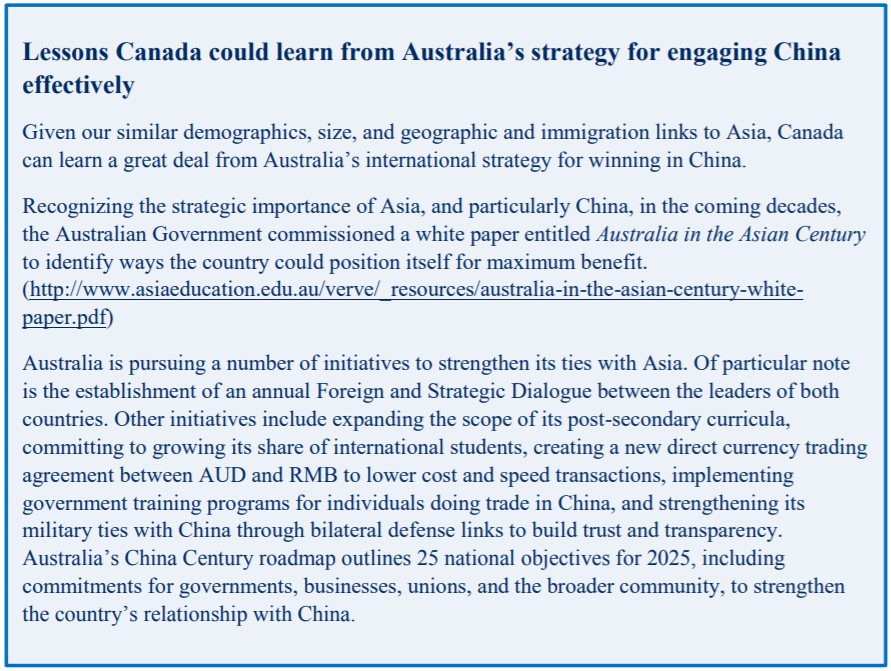
Five ideas for Canadian businesses to capture the China opportunity
- View China as your second home market and be as committed to winning in China as you are to winning in Canada
A number of companies, including the Canada Pension Plan Investment Board (CPPIB), HSBC, and General Electric, have signalled this commitment by moving senior executives to Asia and training future executives in their global role. Some Canadian firms host Board meetings in China, demonstrating commitment to understanding and being present in this strategic market. BMO, Manulife, Power, and EHC Global are just some of the firms who are using this strategy. Canadian Ron Ball, the founder of EHC Global, a company that supplies components to the elevator and lift industry, moved to Shanghai in 1997 to lead Chinese operations and prepare for the inevitable shift in the industry—today, more than 70 percent of elevators and escalators are made in China.
- Understand the market at a granular level and develop a specific value proposition responding to Chinese consumers’ unique needs
China and its megacities comprise multiple consumer segments and 22 regional clusters to be served. Recognizing the differences among Chinese consumers and developing unique value propositions have been key success factors for numerous companies. Nestlé and Kraft, for example, have leveraged the fact that consumers in Hangzhou will pay a premium for safe food by aggressively promoting the safety of their products in that market. Proctor & Gamble extended its reach to
the Chinese “value” consumer and has been able to build a sizable and profitable business by creating a product that costs almost 30 percent less than the premium offerings on the market. Shiseido developed Urara—a brand exclusive to the Chinese market—to reinforce sales in local chain cosmetics specialty stores. Unilever revised its “one size fits all” expansion strategy, prioritizing 15 clusters where it went “deep” with tailored product portfolios and a marketing mix that
resulted in 50 percent higher revenues and 12 percent lower marketing costs, demonstrating that tailoring value propositions can lead to market success.
- Commit to executing as well in China as you do in your global best
practices and fostering capabilities in selected areas
Developing local talent is key to implementing best practices and fostering capabilities in China. To protect intellectual property by segregating Chinese employees or limiting the information given to them is unlikely to make employees feel valued, whereas employees who are developed as part of a broader global entity are more likely to be loyal. For example, one of Bombardier’s strategic goals is to put down roots in all of its key markets, and it has established an HR policy that focuses on hiring and developing local talent up to the management team level.
- Leverage M&A and partnerships to rapidly fill gaps and gain scale
In October 2013, Aimia launched China Rewards (a Shanghai-based startup) through a minority investment partnership with China Union Pay Merchant Services (one of the world’s largest network operators) and Points International Ltd. to capture the opportunity to build the loyalty market in China. Aimia and Points.com will each be investing up to US $5 million. The strategic relationship will create an immediate credible presence and enable the company to establish the business and increase its scale quickly. The loyalty partners found a niche area with no SOEs and a substantial opportunity to build data and grow relationships with Chinese consumers.
Numerous other organizations are partnering with China through training and fora on corporate governance. Recognizing the need for greater shareholder feedback and transparency, Temasek has been training dozens of Chinese SOE directors for the past 10 years on governance topics through the Stewardship and Corporate Governance Centre. Similarly, in Canada, Rotman Professor Don Brean teaches a cadre from the Chinese Communist Party each year. On the international stage, Canada is furthering its reputation for good governance with the launch of a new project to develop Board ratings criteria for public companies in Saudi Arabia where Canada will provide expertise and experience with governance assessments. Canada has considerable expertise in this area, and it is also a strategic way to engage China that will help deepen relationships and partnerships.
- Partner with the government and align your organization’s interests with theirs to gain proprietary opportunities and advantages
Building strong government relations and business partnerships through strategic joint ventures was Ballard Power’s route into the Chinese clean technology market. Recently, Ballard Power announced that it had signed a non-binding Memorandum of Understanding (MOU) with its partner, Azure Hydrogen Corporation of Beijing, extending the scope of their collaboration to include fuel cell buses. It also signed an Equipment Supply Agreement (ESA) for the supply of 220 ElectraGenTM Telecom Backup Power fuel cell systems to be deployed in Chinese telecom networks.
Another example of a Canadian clean tech company that is succeeding in China is Vancouver’s Westport Innovations. The Chinese heavy engine market is nearly 10 times the size of that of the United States, making it an attractive place for Westport to produce and sell its heavy-duty truck engines that run on natural gas instead of diesel. In 2012, the company partnered with a Chinese firm, Weichai Power, the country’s largest heavy-duty truck engine manufacturer and has since experienced 50 percent year-on-year growth. Given the Chinese government’s desire to reduce air pollution, as well as its substantial support for LNG infrastructure, the company is well-positioned for further growth.

Conclusion
The Canada-China Economic Complementarities Study set the stage for discussions regarding high-potential sectors for collaboration between the two countries, but significant opportunities also exist for Canada’s government and businesses to invest strategically in sectors that are aligned closely with the goals China has set. To capture these opportunities, Canada’s public and private sectors will need to make significant additional investments in leadership, relationship building, people development, and trade frameworks that will strengthen our ties with China and advance our mutual interests. Although a number of risks must be considered, China will continue to play a major role in driving the global economy—and Canada is in a strong position to support it. The mutual benefit is there. Together, we can capture it.






